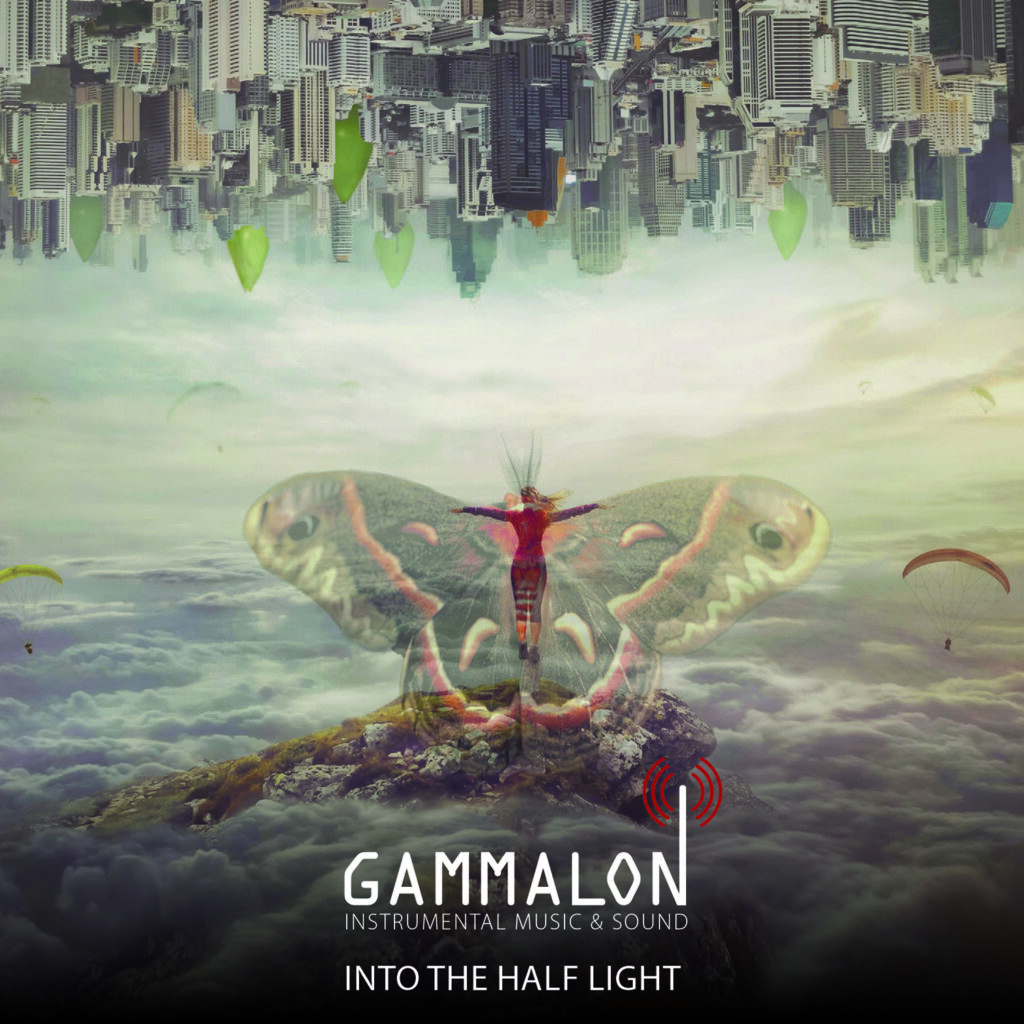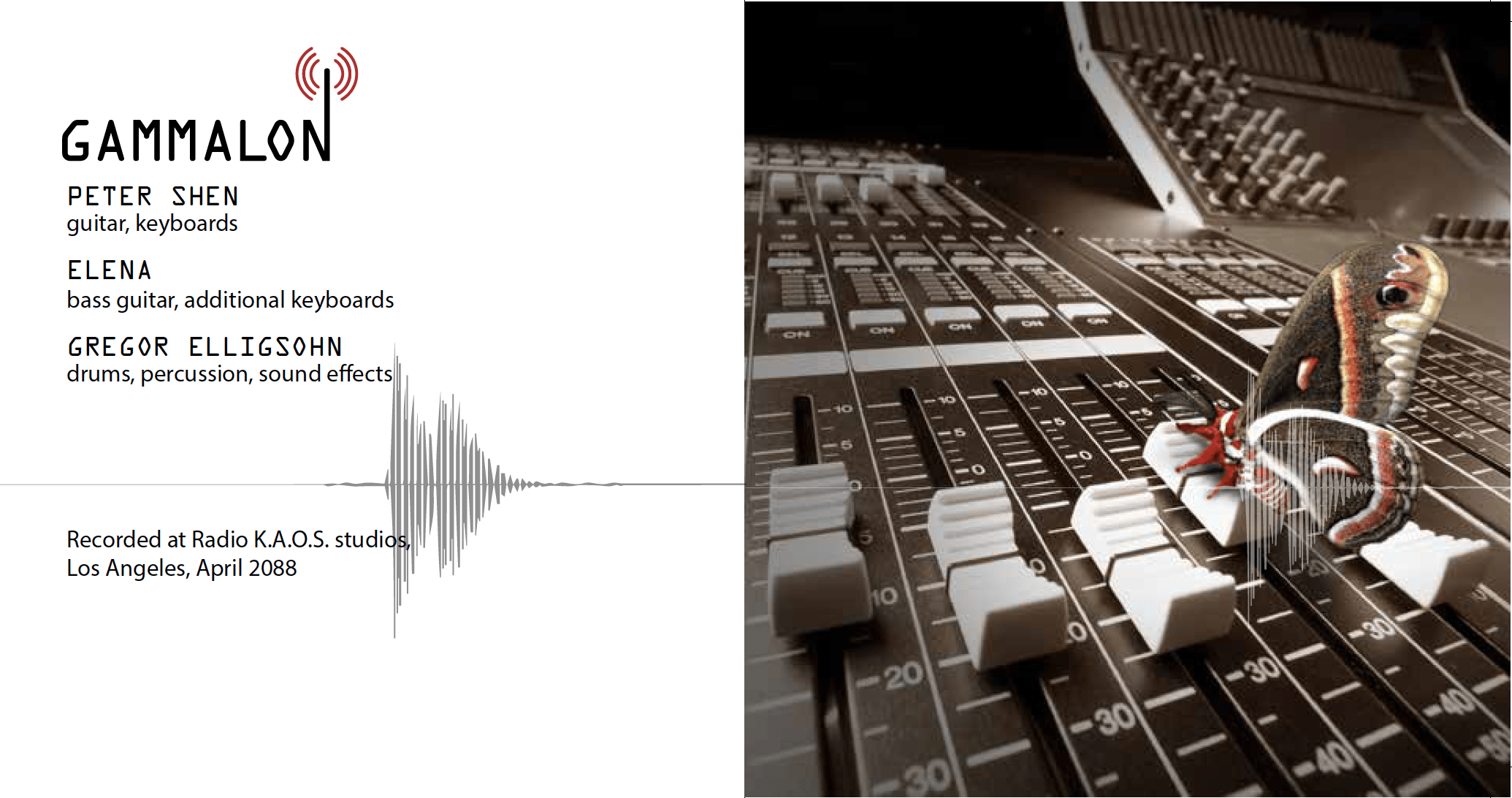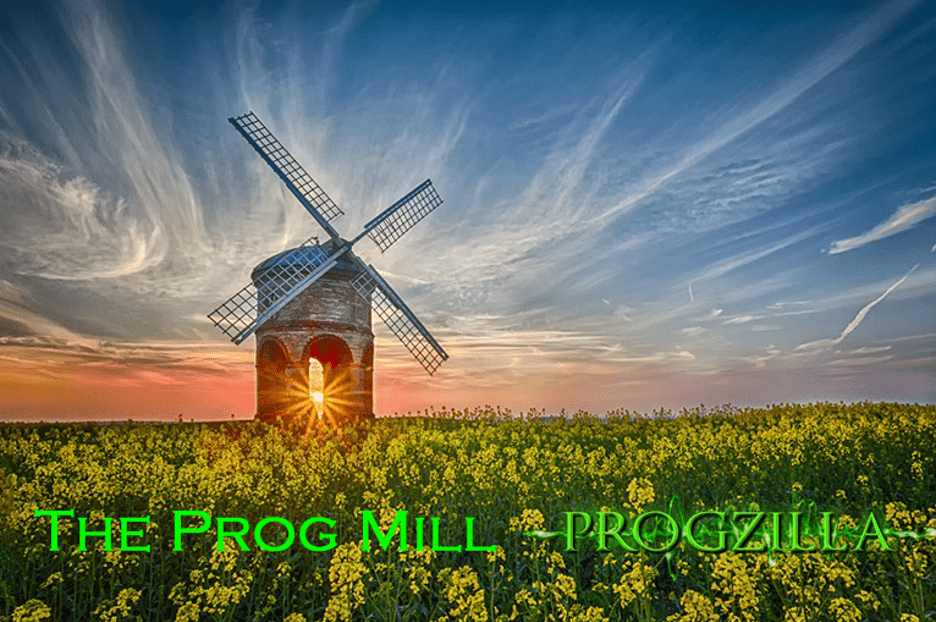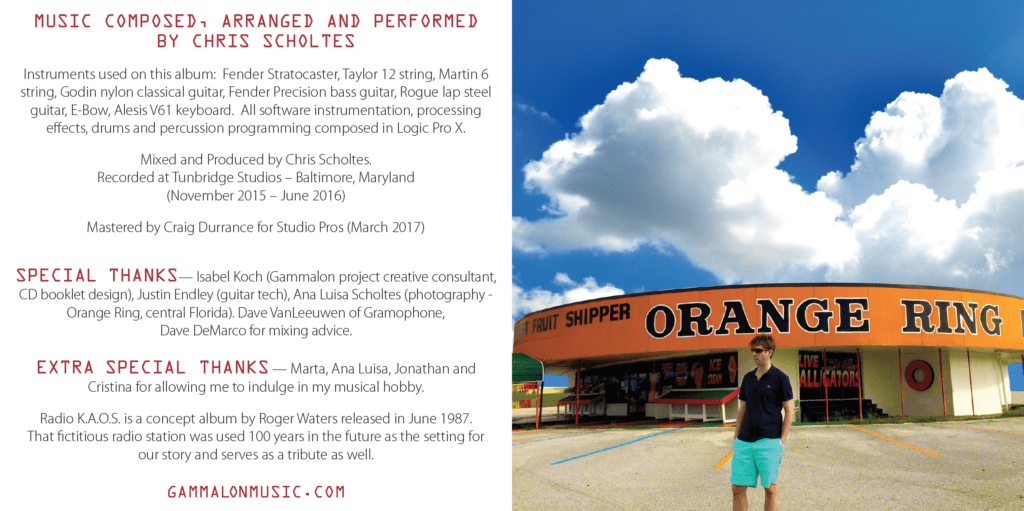Into the half light

A Closer Look
About the Songs
The album opens with sounds of SETI pulses, computer glitches, radio transmission sounds and the like which coalesce then give way to steady, chugging 16th guitar notes and a four-chord sequence (comprising a verse) in a 2/4 time signature which leads to a guitar solo. A piano interlude in ¾ time separates the verses and second guitar solo. The music and sounds seek to convey to the listener man’s eternal pursuit of contact with those beyond our own galaxy.
This is a fairly straight-ahead rock tune that conjures up images of a young couple heading out west to CA to explore the Pacific Coast Highway and the wine country with the top down. A dreamy collection of triads slides overtop the chord structure of the verses. This is a happy song and the mood intentionally shifts up a notch to an even brighter disposition in the outro guitar solo over some major 7th chords.
This is an extended progressive art-rock composition that includes many musical elements and dynamics. A variety of orchestral instruments (primarily string and brass families), a male/female choir, acoustic guitar, heavy rock harmony leads, an ambient dreamy guitar solo and appregiated synthesizers which give way to a heavy metal sequence are only some of the tasty ingredients of this composition. The central anthem is the heavy chordal section appearing 3x in the composition – first as the climax to the opening guitar solo, then twice more in the song introduced by lead harmony guitar bends. Perseverance’s final climax mirrors the opening four-chord sequence, but is now flourished with a climbing harmony guitar melody that culminates with some dramatic staccato snare hits.
This composition chronicles the long and difficult journey of determined pioneers who brave the terrain, harsh weather and the risk of encountering crazed gamma-morphed creatures in Gammalon. There is much danger to
overcome in order to reach the safety that awaits behind the guarded walls of Camp Pacific Freedom.
We’ve found more great old movies in the Radio K.A.O.S vault. This subterranean musical journey in six sections is inspired, in part, by a movie called, “The Abyss” which was released a lifetime ago in 1989. The sequence of underwater musical movements are as follows…
Part 1: Descending the Fathoms – This is the central part of the song and features a repeating watery guitar motif. A slide guitar launches into a sequence of several picked-out guitar chords resolving on Emajor and then returns to the darker submarine motif.
Part 2: Coralscapes – “Coralscapes” provides great counterpoint and respite from Part 1. It is a soothing, calming and very tranquil passage. We see the diver glide through shallow depths, the sunbeams piercing the crystalline aquamarine water revealing the city of corals below which, like a projector reel, scroll beneath his swimming form. Part 2 swells to a powerfully dramatic and elongated crescendo and introduces part 3.
Part 3: Raptures of the Deep – This very brief section seeks to paint a picture with a collage of sound and not with music. “Raptures” captures the sounds and images of a long and slow, dark and purposeful decent straight down.
Part 4: Hallucinations and Inner Beauty – sinking like a stone, our diver – with weighted boots – descends hundreds of feet, succumbing to crushing pressure and the inevitability of gradual oxygen deprivation. He’s overcome with a sense of euphoria, peace and surreal beauty. Consciousness and awareness flicker like a dying incandescent light bulb popular in the previous century. Such is man’s determination to pursue Earth’s final frontier. The music that accompanies this section begins with a picking pattern in an unnatural tuning on a classical guitar with nylon strings. An orchestration of strings, piano, brass and glockenspiel adds layering and texture. The
progression builds to the refrain of the song’s anthem in part 5.
Part 5: Descending the Fathoms (reprise) – This section of music is a refrain or return to the central watery guitar motif and re-centers the composition to provide a sense of musical cohesion.
Part 6: Surfacing – Part 6 finds our diver, miraculously rescued by divine intervention, climbing towards the shallows. The water transforms in infinitesimal gradations of murky midnight black to soft royal blue as he ascends. The warm sunlit shallows embrace him. The 10-note rising dissident chord sounds the ascent and we hear with relief the surface sounds of lapping waves and a faintly clanging bell buoy through the misty, salty sea-spray.
This is a straight-ahead rock tune that features a crunchy hard rock refrain in Bminor7. The verses serve as musical counterpoint to the heavy refrain as they are constructed with a lighter, more delicate piano melody. The title gives us our first clues of the evolving relationship of Peter and Elena from close friends to something more.
The previous album, “Flamethrower” gave us the short piano composition “Summer of Ana Luisa” which served as a tribute to Peter’s great grandmother. A second short piano composition, “The Winter of Jonathan,” has been written for this album and serves as a tribute to Peter’s great grandfather.
The album’s title is taken from this composition which essentially makes this piece the title track. There are two distinct sections to “Crossing Into the Half Light.”
Part 1: The Deep Sleep of Past Lives – The droning note of a desolate landscape is overtaken by an up-tempo electronica beat and pulsating rhythmic synth notes which support the main verse melody. The main melody appears as bookends in Part 1 and is divided by an overdriven lead melody section which slides back out returning to the coupleting main melody. A
long slow fading wave-synth chord provides the transition to Part 2.
Part 2: Awakened – This section features a repeating Fender Rhodes jazz piano riff with various textures accented overtop, including sparse piano fills, a modified dobro and other ethereal sounds. The repeating Fender Rhodes riff becomes expanded for more notes providing now a chordal shift. A majestic string melody takes hold over the jazz piano figure and blooms in harmony lines overtop the Rhodes to a crescendo. We’re left with just the original jazz piano riff, chordal string movements and the electronica subtexture. That form gives way to the denouement of a pastoral outro chord sequence.
“Postcards” is constructed in a more traditional song style having clear verses and chorus and not long building passages of music. It opens with an appregiator over a chord sequence with bass guitar fills. Acoustic and electric guitars outline the verses and chorus. A powerful fuzzy guitar solo adds some impactful dynamics and gears the song up into overdrive and returns the listener to the peace of the traditional verse/chorus sequence. “Postcards” is a time travelling musical literary beacon from Peter, Elena and Arturo to their middle aged great grandparents whom they miss so much.
AFDIM is a regrettable tribute to our close friend and drummer and sound fx specialist. Art suffered from a very late stage of mutated radiation sickness. He gamma-morphed slowly, quietly and with excruciating pain. He hid the slow change well. The process drove him mad. His long-hidden symptoms have all the colonists in Camp Pacific Freedom wondering who else might have a dormant version of the radiation poisoning. They say “Not everyone is who you think they are.” It is this time of fear and uncertainty that has inspired the title of the album “Into the Half Light.”
Musically, the piece opens with a very percussive section of building electronica and heavy drums which supports the melody of layered guitars. This passage serves to open and closes the composition. There are two extended middle sections between the couplets. The first of these two sections features the cascading cacophony of maddening sounds that
translates for us Arturo’s mental anguish that consumed his last days. We freed him with the Flamethrower that we liberated from the West Hollywood armory. From those dreadful sounds emerges a very different counterpart musical sequence of orderly appregiated notes, tight bass and locked in drums with double hi-hat time and a screaming distorted extended slide solo layered on top.
The third and final verse and solo of Echodust is featured here as a reprise to the opening of the album. Preceeding this third and final verse and solo are the same piano note sequence that bridged verses one and two in Part 1, only this time the piano note sequence opening Part 2 is very slow, purposeful and like a dirge of resounding notes drenched in reverb. Loud flutes accompany the eerie piano melody until crashing thunder transports the listener to a swirling section of rainstorm and piano effects that become overtaken with a heavy synth solo that serves as a bridge to the final verse.
This piece serves as a musical tribute to Peter’s great aunt, Amy, who passed away suddenly and mysteriously. The pearls represent stars of many beautiful memories in the twilight. Musically, this piece features melodic guitar lines that seem to cry out with questions, angst, sadness and ultimately hope.
Peter's Story
Gammalon
West Hollywood, CA
April 19, 2088
It’s been 16 months since the nuclear mega-plant meltdown in Japan changed everything. Pacific trade winds carried poisonous radiation across the earth, and like a horror movie, the unlucky ones transformed. They gamma-morphed into creatures consumed with an unquenchable rage and hunger. We are their prey, but the camp in Hollywood is well protected with lookouts, a 20’ high concrete wall and, of course, the Flamethrower.
Our tiny colony of survivors is adapting, and in many ways, thriving. Somehow, we are alive and seemingly unaffected due to an immunity found in about 4% of the world’s population. The radio message is successful, and we are frequently welcoming small bands of people from all over. Our drinking water is clean, and the farms are producing crops for food and fuel. We are carving out a new way of life.
Arturo is dead. He’d been acting strangely for the last two months - secretive and increasingly aggressive. His drumming had also become erratic. He hid his physical gamma-morphing well, but unlike those who turned after the Incident, his descent into madness was gradual.
After padlocking the radio station doors, he set the cantina on fire - with Elena and me in it. We managed to escape with the help of the fire brigade, while Arturo slipped away in the chaos. We departed Camp, and two days later we tracked down the half-man that was once Arturo. There, in the nearby forests of Runyon Canyon Park, we set him free with the Flamethrower. Arturo’s transformation is the first of its kind in Gammalon. Its long dormancy has everyone alarmed. How many others among us are not truly immune, but secretly, quietly turning and not yet showing signs?
In the wake of Arturo’s death, Elena and I have grown even closer, but musically, we languished. Our new drummer, Gregor Elligsohn, a recent and hopeful colonist, pushed us to heal and grow by reigniting our passion to complete this album. But even now, with the darkness of paranoia tightening, we find ourselves crossing over Into the Half Light of Gammalon.
To be continued...
The Musicians
Album Credits

Into the Half Light
Gammalon on UK Radio
“I got wind of your album on the Prog Mill and I’m trying to nail down a CD copy. Love the album. Looking forward to the CD. I present a show called My Musical Box of Tricks which goes out on 3 UK [radio] stations during the course of a week, so I like to have the best quality I can for my listeners. Take care and good luck with the future project [The Periphery of Imagination], please don’t forget to land me one when completed.”
– Colin Reynolds, UK.
Gammalon appears on Progzilla Radio, UK on July 26, 2020!

Click here to access the audio player of the July 26, 2020 show which features Gammalon’s “Heading West” at 1:10:40 (one hour, ten minutes, 40 seconds).
Gammalon would like to thank Shaun Geraghty ([email protected]) for selecting our music for a Progzilla show. What an honor! Thank you to Shaun for the very nice compliments of Gammalon on your show too.
Edition 220 of THE PROG MILL for Progzilla Radio (440 in total), first broadcast 26 July 2020, is now also available to listen to anytime or download.
Here’s This Week’s Playlist
1 Deep Purple – Nothing at All (Whoosh)
2 Monjoie – Ode on a Grecian Urn Part 5 (Love Sells Poor Bliss For Proud Despair)
3 Gazpacho – Fireworker (Fireworker)
4 David Minasian – The Sounds of Dreams – Third Movement (The Sound of Dreams)
5 The Kaos Collective – Equinox (Equinox)
6 That Joe Payne – By Name, By Nature (By Name, By Nature)
7 Darryl Way – Riviera Blue (Destinations)
8 Gammalon – Heading West (Into The Half Light)
9 Frost* – Drown (Others)
10 Steve Rothery – Kendris (The Ghosts of Pripryat)
11 Genesis – Phret (B Side of Shipwrecked)
12 Mercury Rev – The Dark is Rising (All Is Dream)
13 Looking Glass Lantern – Six Pearls to Mary (A Tapestry of Tales)
14 Magenta – A Gift From God (Masters of Illusion)

The Prog Mind Reviews
"Into the Half Light"
” I love stumbling upon hidden gems. A couple months ago, I randomly saw a post about a band named Gammalon, and the cover art was beautiful (I’m a sucker for that). As I listened to the album, called “Into the Half Light”, I could not believe that the artist hadn’t been spread far and wide in our community. The album originally released a few years ago, but is back for a re-release this year, with another album releasing relatively soon, as well.”
“I’m interested to know more about this project. I run theprogmind.com, and I just heard Into the Half Light, and it is magical!”
Jason Spencer
Into the Half Light
Interview
Conducted by George Georgiou for Rockway in Greece (www.Rockway.gr)
Click Here for Online Interview Link
July 3, 2020
First of all, thanks for offering to interview me, George. I suppose I would introduce myself as an artist who has an appreciation for many elements of music and sound. At heart, I’m a progressive/art rock fan, but I love to incorporate elements of many other styles including electronica, jazz-fusion, hard/heavy rock, classical and spa music. I’m also a big believer that the human ear doesn’t only love to hear music, but also loves the textures of various sounds and sound effects. Those “non-musical sounds” can range from being beautiful to mysterious to haunting and everything in between. Sounds, as well as music, very much help tell the story of a composition and serve to paint a picture for the listener. This, I think, is even more meaningful with instrumental music where there are no lyrics to tell a musical story.
Definitely Pink Floyd for sonic texture, wide expanse and palette of tones. I also think Pink Floyd’s creative genius can also be found in how they infused their music with sound effects to convey musical messages. Beyond Pink Floyd, I’d say the other two key inspirations for the Gammalon sound would include Rush (prog. rock influence) and Pat Metheny Group (ambient jazz fusion and Americana jazz influence). But there are so many other more subtle musical influences on these Gammalon albums, from Frank Zappa to Metallica to Tangerine Dream. Also, a good deal of the music is inspired by the imagery of great cinematography, particular from such artists as Stanley Kubrick and Godrey Reggio (Koyaannisqatsi). Much of the instrumental music that I’ve written is sort of a surreal musical landscape of soundtracks for real and dreamed up films, short scenes and even still images. I love creating an aural landscape that conjures up images in the mind of the listener.
Although I’m a guitar player primarily, I’m really inspired by piano/ keyboard players. I sometimes think that keyboard players don’t get the same recognition that guitar players do in contributing to the overall sound of a band. Regarding Pink Floyd and Pat Metheny Group, sure David Gilmour and Pat Metheny are huge influences on me, but as much and sometimes even more so are their colleagues on piano – Richard Wright and Lyle Mays, respectively.
The Gammalon Instrumental Music and Sound project and related storyline was born out of an inspiration to be more creative and interesting than simply delivering a “Chris Scholtes solo project.” I’ll try to be as succinct as possible on the premise: Gammalon is our world 100 years in the future where only 4% of the population remain alive. A nuclear energy facility in Japan was targeted for attack by some doomsday cult in the year 2087. The “Incident” as it’s known across the multi-CD story, sent gamma radiation across the Pacific ocean to California and the rest of the US via Pacific trade winds. The setting is in downtown Hollywood, CA around which surviving colonists have erected a protective wall and named their pioneering community as “Camp Pacific Freedom” (CPF). The wall protects them against a portion of humans who did not die from radiation, but instead have “gamma-morphed” into raging, violent facsimiles of their former selves. Our central characters are colonists and musicians, Peter Shen (gtr, keys), Elena (bass, keys) and a new drummer on each album (they all keep dying in bizarre ways – kind of a humorous nod to the legacy of Spinal Tap drummers). Gammalon is also the name of their band that has taken up residency in the Radio K.A.O.S. radio station on the Sunset Strip, a tribute to Roger Waters (NOTE: Radio K.A.O.S. is a Roger Waters solo album released in 1987). It is here where the central characters have recorded their albums. With each album release, Peter pens a memoir on the current status of daily life and strange goings on in Gammalon and CPF. His ongoing memoirs are captured in the liner notes of each CD and serve as periodic windows to that world.
The feedback has been very positive and there is even a location on the new website for praise for each album. I’m just about finished the third album, tentatively titled “The Periphery of Imagination” (due out by September 2020), and the demo for that album has already received an excellent review from Dave DeMarco who wrote extensively for Atlantic Music Monthly.
Technology is often a double-edged sword. Technology gave us Pro-Tools and Logic Pro X, digital audio workstations and the like, but technology has also made it difficult for artists to make money on new music. The money’s made in performing live and selling T-shirts. Websites are becoming more interactive and social media is really a great way to maintain contact with fans, which appeals to me.
Just last week I was introduced to a band called Night Wish from Finland by one of my brothers-in-law. Holy smokes. I was blown away. They are not a new band, but are new to me. Their style is symphonic-metal. There are full-on orchestral passages and metal guitars, beautiful soaring female vocals and a sort of renaissance type flair in certain songs/passages. Very powerful and moving music. I do have to admit that my biggest affinity for music is 70s AOR in general.
Such an inspiring and humbling question. I think that since so much of the Gammalon Instrumental Music and Sound project reflects cinematic elements that it might be fun someday to compose and arrange scores of music for film and movies.
Well, I suppose like most musicians, my life changed at the age of 6 when I first heard the Beatles, and specifically for me “Day Tripper.” So, certainly John Lennon (or all 4 of them) comes to mind, but he would not be the right partner with me for Gammalon’s style of music. So, I would go with: Lyle Mays, Richard Wright, Geddy Lee and Neil Peart with Bob Ezrin producing.
Q: Why do you still have a Roland Boss ME-5 from 1988 on your pedalboard? A: The Boss ME-5 Guitar Multiple Effects was the first multi-effects floor unit the company produced. The Compressor, Overdrive/Distortion, Equalizer, Chorus/Flanger, and Digital Reverb/Delay effects it used simply employed the internals from the made-in-Japan Boss modules offered at that time (specifically the CS-2, DS-1, OD-2, RV-3, EQ-1, CE-1, DD-2, and BF-2). Because of these vintage pedals being embedded in the unit, these have become increasingly sought after. Like all multiple effects pedalboards, the great part is having the ability to use these effects together to create and edit customized patches and call them up on the fly. I actually own two ME-5s. One is a backup.



